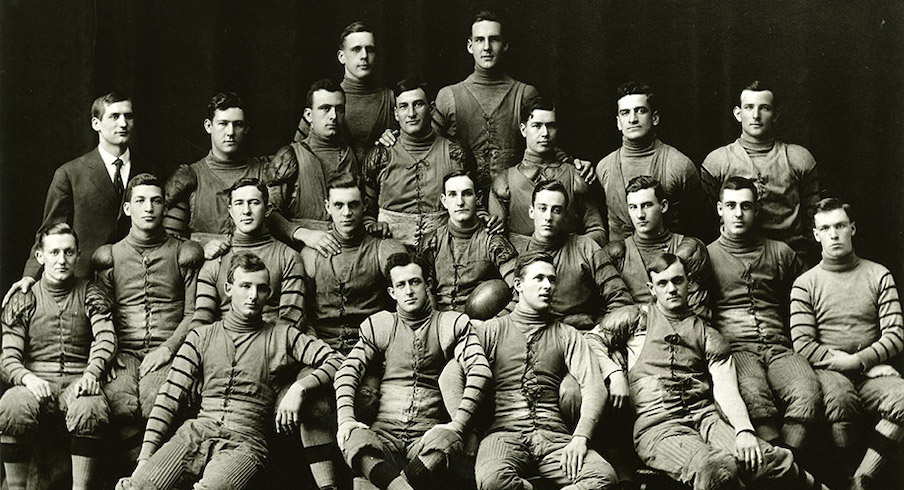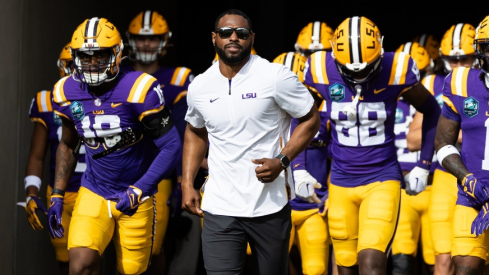Before Ohio State vs. Michigan before a Thanksgiving week tradition, Ohio State had a Thanksgiving Day rivalry game with Kenyon College. We take a look back at the history of Ohio State’s first rivalry.
Ohio State football games were intimate affairs with only a few thousand fans in attendance for the first 20 years or so. The games offered their own charm, yet were often quite exhilarating. Photographs of games at Ohio Field show crowds of mostly men in hats craning their necks, and it’s not uncommon to see boys hovering above, perched on the power poles and in the trees that circled the field.
Kenyon was Ohio State’s first big rival, and for many of the Buckeyes’ early years, the season’s climax was the Thanksgiving Day game in Columbus between the Men of Scarlet and Gray and the purple-clad Episcopalians. Between 1890 and 1912, Ohio State played an annual game on Thanksgiving (except for 1891), and 12 of those 22 games were played against Kenyon.
| YEAR | OPPONENT | SCORE |
|---|---|---|
| 1890 | Ohio State vs. Kenyon | 10–18 |
| 1892 | Ohio State vs. Kenyon | 26–10 |
| 1893 | Ohio State vs. Kenyon | 8–10 |
| 1894 | Ohio State vs. Kenyon | 20–4 |
| 1895 | Ohio State vs. Kenyon | 12–10 |
| 1896 | Ohio State vs. Kenyon | 18–34 |
| 1897 | Ohio State vs. Ohio Wesleyan | 0–6 |
| 1898 | Ohio State vs. Ohio Wesleyan | 24–0 |
| 1899 | Ohio State vs. Kenyon | 5–0 |
| 1900 | Ohio State vs. Kenyon | 23–5 |
| 1901 | Ohio State vs. Kenyon | 11–6 |
| 1902 | Ohio State vs. Indiana | 6–6 |
| 1903 | Ohio State vs. Indiana | 16–17 |
| 1904 | Ohio State vs. Carlisle Indians | 0–23 |
| 1905 | Ohio State vs. Indiana | 0–11 |
| 1906 | Ohio State vs. Ohio Medical | 11–8 |
| 1907 | Ohio State vs. Ohio Wesleyan | 16–0 |
| 1908 | Ohio State vs. Kenyon | 19–9 |
| 1909 | Ohio State vs. Kenyon | 22–0 |
| 1910 | Ohio State vs. Kenyon | 53–0 |
| 1911 | Ohio State at Cincinnati | 11–6 |
| 1912 | Ohio State vs. Michigan State | 20–35 |
| 1917 | Ohio State vs. Camp Sherman | 28–0 |
In 1892, the Ohio State students who operated the athletic board decided to schedule the game with a 10 a.m. kickoff with the idea that the morning start would provide ample time for everyone to get home for supper. (It’s not clear how the meal’s preparers were accounted for.) The 10 a.m. kickoff was advertised in Columbus publications and taverns but wasn’t clearly communicated to the Kenyon team.
There was a dance in Gambier the evening before, and no one was planning on coming to Columbus until after noon on Thursday. When word of this reached the OSU campus, Ohio State’s business manager Walter Sears jumped on a train to Gambier hoping to bring the team back with him. Sears failed in persuading the Kenyon players to skip the dance so he sent a telegram with orders to “Put a big notice in the morning papers” about the time change and “placard the city and give as much publicity as possible.”
Unfortunately, Sears’ telegram arrived after the morning papers had gone to press, so players and supporters spent the early morning hours making posters and placards to notify the city of the scheduling snafu and the new start time. A wagon was secured from a campus-area drayman and loaded with members of the band. Their morning was spent being pulled throughout the city while they banged their drums and blew their horns trying to get the word out.
As feared, horse-drawn carriages and tally-hos loaded with spectators began arriving expecting a morning kickoff. Despite the inconvenience, few left and the crowd just grew as the day wore on. In the end, the mix-up and subsequent alerts to the change of time could have helped boost attendance as an estimated 1,200 fans attended the game.
The fans were treated to a “glorious struggle and glorious victory” as Ohio State defeated Kenyon, 26-10, for its first-ever win over Kenyon after losing to its rival in 1890 and 1891.
Following the next game between the schools in October 1893, a telegram was delivered to the Ohio State dorm that said Ohio State had won that afternoon's contest in Gambier. A spontaneous celebration erupted, “everyone went wild, horns and guns were produced and used vigorously” as students reacted to the unexpected news of “such a glorious victory.” Students emptied the dorm and marched down High Street to Union Depot to greet the returning victors, as documented by The Lantern:
With colors flying and horns blowing the team and those who had accompanied it marched down High St. to the time of O. O. , O. S.U. Scattered through the ranks could be seen the participants of the struggle. They were easily distinguishable, one unsophisticated bystander desired to know whether they were the survivors of a railroad wreck. Or whether they had fallen off the Ferris wheel….
[Fans] marched on ignorant of the fact that they were wasting their enthusiasm on a team which had been ignominiously defeated during the afternoon, but it soon became whispered around that the score was not O.S.U. 22, Kenyon 16, but Kenyon 42, O.S.U. 6.
The telegram had been a prank sent by Kenyon students.
Ohio State would win only three of its first nine games against Kenyon, but a 29-0 setback in 1898 was the last time the Scarlet and Gray would lose to the Lords. Following that loss, Ohio State officials hired Kenyon’s coach, John Eckstorm, and OSU experienced its first period of sustained success. The Buckeyes never lost to Kenyon again, winning 13 straight games against Kenyon from 1899-1911 including six Thanksgiving games.
After joining the Western Conference in 1912, the Buckeyes played Kenyon only once more, defeating Kenyon 54-0 in the final meeting between the two schools in 1929. Ohio State finished the series with a 17-6 all-time record.
Ohio State’s tradition of playing annually on Thanksgiving also ended once the Buckeyes began playing a Western Conference schedule in 1913. The only other Thanksgiving game Ohio State would play came in 1917, when they played Camp Sherman – a World War I military installment – in an exhibition game.
As a boy, James Thurber was among a group of friends who regularly made their way to watch the battles on Ohio Field. The great humorist attended Ohio State, although he left before earning a degree. In 1950, however, Kenyon College bestowed on him a Doctorate of Letters degree. Thurber wrote a colorful piece about attending the great Thanksgiving games between these schools as a boy, which appeared in Thomas Boardman Greenslade’s “Kenyon College – Its Third Half Century”:
When I was 12 years old, the great football event, the annual gridiron classic, was the final game of the season between Ohio State and the powerful Kenyon eleven.
The Ohio State-Kenyon game had to make up in color and side-show for what it lacked in quality. The Kenyon classic was always held on Thanksgiving Day. Everybody got in his surrey or Thomas Flyer and drove to Ohio Field in a jovial mood, full of Madeira, Turkey and mince pie.
The color scheme itself was worth driving north to see; pumpkins and corn and dahlias, hedge apples and scarlet and gray banners and a big turkey cock dyed a deep purple. Perhaps it was this strutting mascot that riled the Ohio State rooters. Anyway, the Kenyon game usually ended in a free-for-all.
The menfolks would climb out of the stands, or the surrey, or the auto, and swarm onto the field, yelling for Gambier blood, while the womenfolks stayed behind, throwing hedge apples at everything purple that dared show its head or wattles.
Thurber recalled an altercation he and his buddies had witnessed between an Ohio State “rooter” and a Kenyon loyalist while returning to the eastside in a streetcar. The fight erupted somewhere along Oak Street. The motorman immediately halted and tossed the pugilists off of the car. “‘Gol dang it,’ Thurber quoted the motorman, “football fights should be fought north of Buttles Avenue. People out East here have something better to think about.’”
While Thurber’s description is likely a composite of a number of games, the 1908 Ohio State-Kenyon tilt that took place just days before his fourteenth birthday surely left a lasting impression. The game drew a “record” 7,000 fans in what was a truly festive atmosphere as confetti and “sis-boom-ahs” of the “skyrocket” yell filled the air. And if newspaper reports are to be believed, someone really had dyed a turkey purple and brought it to the game.
The rivalry became so heated that officials from both schools had considered halting contests between the adversaries after a melee almost broke out during a basketball game that year. Kenyon came into the football game undefeated, having outscored its opponents 226-10, but Ohio State’s 19-9 win thwarted Kenyon’s claim for the championship in the Ohio Athletic Conference, which then included Case, Kenyon, Oberlin, Ohio Wesleyan, Western Reserve and Ohio State.
You can learn more about the early years of Ohio State football in the author’s book “Days of Yore: The Men of Scarlet and Gray,” which is available for purchase on Amazon. You can follow McQuigg on Twitter @dpmcquigg.


